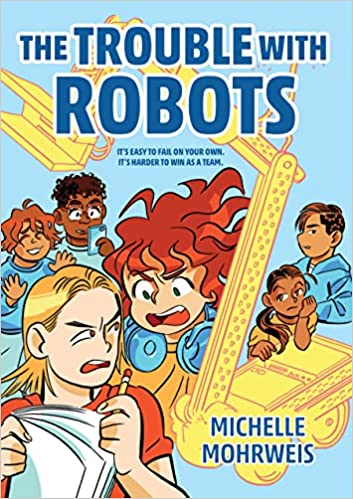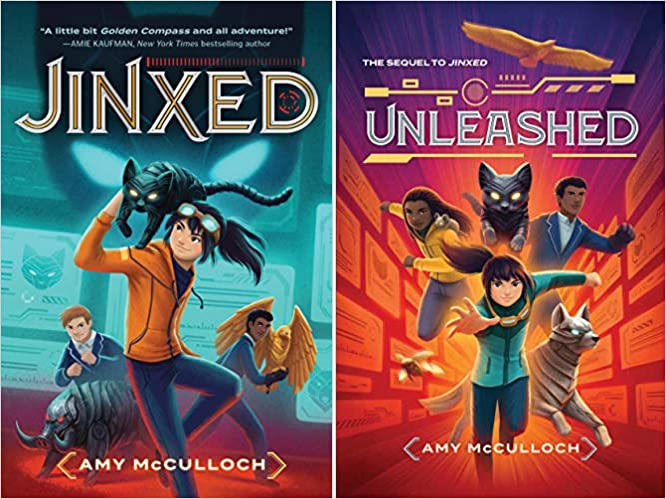This is the story of a team of students participating in a robotics competition. The viewpoint alternates between two girls on the team, Evelyn and Allie. Evelyn is the team’s leader, and has loved robotics for years. She is especially motivated to win the robotics competition, for a couple of reasons. If the team gets to nationals she will see her best friend Naiely who recently moved away. She’s also trying to attract the attention of the Tech Tigers, who frequently have a strong team. If she can get them to recruit her to their team in the future, she’d greatly increase her chances of a college scholarship, which is important because money is tight in her family. Evelyn is so concerned about winning, though, that she is taking too much control of the robot. Since she won’t let her teammates do much, they’ve lost motivation and aren’t helping. The team is far off-track and everyone is frustrated to the point where their teacher is threatening to take away Evelyn’s leadership position. Allie is completely uninterested in robotics, but is forced to join the team when the school principal gives her one last chance to get her behavior under control. She doesn’t mean to cause trouble, but has been bottling up her emotions about her parents’ recent death, and tends to explode in anger at her teachers and classmates. She is trying to keep to herself and just work on her artwork, but doesn’t really understand how lonely she is inside.
This book earns an A+ for diversity and inclusion; it’s actually amazing how much representation is packed into this book. It has great racial and gender diversity. There is a lot of LGBT inclusion: Allie is asexual and/or aromantic; their teammates Santino and Alex are a couple; Evelyn has two moms, and has a crush on the non-binary captain of the Tech Tigers. Evelyn is autistic and gets irritated by crowds and loud noises, wearing headphones most of the time to keep sound levels down. And besides Evelyn’s two moms, non-traditional families are also represented by Allie now living with her aging grandmother. There’s no romantic comment more serious than some crushing and hand-holding.
It also earns an A+ for STEAM representation. The students are actively doing work on their robot, code, and the record of their work and their learnings in their science notebook. There’s an explanation of gear ratios, and a fantastic portrayal of growth mindset in trying, learning from failure, and looking at other teams’ approaches to get lessons and inspiration. The author has first-hand experience taking students to robotics competitions, and not only does it show, but it makes me want to send my kids to her class! I wish all students had a chance to experience robotics the way the characters in this book do.
There is a lot of greatness packed into this book, but one of my own personal take-aways was the important reminder that fun is important, too. There’s a point where the team is recovering from some upsetting news, and a huge paper-ball fight lets them blow off some steam and return to being able to focus on their robotics work. I didn’t expect to take any personal lessons away from a kids’ book, but when I got to that scene it inspired me to organize a social for my team at work. I also like the reminder in this story that the local bully has their own problems going on at home.
This book is appropriate for any mid-grade reader, age 9-12. It would be especially exciting to kids who like robotics, programming or art — but honestly, I like encouraging any kid to get a little more into these subjects. The story is engaging, the characters are relatable and realistic, and it’s packed with STEM goodness. If you’ve got a young one in your life, definitely share this book with them!
And another note: there’s a sequel coming! We still need to hear what happens when the team gets to the next level of competition.
Find The Trouble with Robots on Amazon at The Trouble with Robots.
For reviews of other books featuring diversity in engineering, tech, and growth mindset, see STEM Area: Engineering, STEM Area: Technology and STEM Area: Growth Mindset.
For reviews of other books featuring gender diversity, racial diversity, LGBTQ+ and neurodiversity in STEM, see Diversity Type: Gender, Diversity Type: Race, Diversity Type: LGBTQ+, and Diversity Type: Neurodiversity.
For reviews of other books that are great for the 9-12 year old age range, see Age Group: 9-12.
For a listing of other books that feature gender/racial/LGBTQ+/neuro diversity in technology for this age group, see Books – Stemverse. Also see our full STEM listings of books and other resources that feature diversity in STEM.





